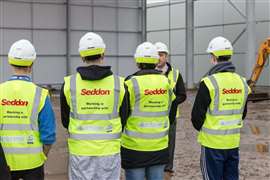Read this article in Français Deutsch Italiano Português Español
Are assumptions about the causes of construction’s recruitment crisis wrong?
20 May 2025
A new report from Dodge Construction Network suggests that safety isn’t just a jobsite issue: it’s a core reason the industry is struggling to attract new workers.
 Image generated using AI
Image generated using AI
Dr Donna Laquidara-Carr, industry insights research director at Dodge, presented findings from a wide-ranging workforce study in a recent webinar hosted by the National Institute of Building Sciences.
The study surveyed more than 1,000 people in the US between ages 14 and 44, including students, job seekers, and career switchers, as well as 260 commercial contractors.
While the results revealed some familiar concerns about labour shortages and retention, they also uncovered deeper mismatches between industry perceptions and the expectations of potential recruits.
Above all: Safety is the unspoken deterrent
 Dr Donna Laquidara-Carr, Dodge Construction Network
Dr Donna Laquidara-Carr, Dodge Construction Network
The number-one reason young and mid-career workers avoid construction? Safety.
Or, more specifically, a perceived lack thereof in the industry.
“Surprisingly, it topped the list,” Laquidara-Carr said. Nearly half of all respondents cited safety concerns as their primary reason for not pursuing construction, which is far more than pay, physical labour, or even a lack of interest.
Dr Laquidara-Carr notes this is ‘surprising’ compared to inside perceptions: Contractors ranked safety as only the eighth most likely deterrent.
That disconnect, according to Laquidara-Carr, reflects a breakdown in messaging. Many contractors have invested heavily in safety culture, zero-injury goals, and proactive jobsite practices. But, outside the industry, the dominant image is still shaped by crane collapses and cable news headlines.
Ultimately, the public at large sees construction as dangerous, while those working within have seen monumental improvements in both the short- and long-term. Still, the industry is one of the country’s most dangerous: there was a fatal injury rate of 9.6 per 100,000 full-time equivalent workers in 2023, which is much higher than the private-sector rate of 3.5 per 100,000 workers.
Laquidara-Carr said the solution lies in better public-facing communication:: “We are not doing a good enough job of telling the story. People are forming their opinions from news coverage, not from inside the industry.
“Where are they learning about what goes on in the industry? With safety, they’re learning about it from the news: a crane fell over, killed two people.
“This is what they hear. This is where they get exposed to what it means to work in construction.”
As for those already in the industry, Skanska assistant project manager Peter Mon, who began his construction career in 2018, agrees that culture and development shape how young professionals view the industry.
“The first step in really attracting young talent is just engaging with them and helping them understand what a career in construction really looks like,” he told Construction Briefing.
Mon said that visibility into meaningful work also plays a role in keeping young engineers motivated: “There’s immense pride when you take a step back and actually see a product that your work has developed.”
Culture and flexibility: missing opportunities
 Construction workers walk towards a site. (Image: Adobe Stock)
Construction workers walk towards a site. (Image: Adobe Stock)
While compensation and advancement chances ranked highly, respondents placed equal or greater weight on a supportive work environment. Flexible hours and positive culture were rated as essential by students and job seekers, yet most contractors ranked those features near the bottom.
One in four contractors surveyed said they experienced project delays due to workforce turnover. Among companies that invested in training and mentorship, delays were significantly less common. Still, many small firms remain hesitant to provide training beyond immediate job tasks, fearing they’ll lose skilled workers to competitors.
“Workers want to stay where they’re being invested in,” Laquidara-Carr noted.
But culture is more than mentorship.
Toxic or discriminatory environments were among the top unexpected issues reported by contractors themselves. “The second highest response to our open-ended question (what surprised you about the industry?) was: toxic or discriminatory culture.”
If construction wants to build a resilient workforce, she argued, it must rethink how it talks about – and practices – inclusivity.
“Mentoring is really important, but not just for the people already identified as future leaders. People want to be with organisations where they can understand and see growth,” Dr Laquidara-Carr said.
She added that inclusion is also about who sees a path forward. In prior studies, only 25–30% of firms provided leadership development beyond their chosen few. For construction to become a career of choice, it needs to demonstrate growth pathways for a diverse set of workers, not just the ones who “look the part”, she said.
Technology hook: Not the youth magnet some think it is
 Peter Mon, Skanska
Peter Mon, Skanska
Responding to Construction Briefing on whether technology can attract younger workers, Laquidara-Carr was cautious.
“Most contractors don’t find it to be an effective recruitment tool,” she said.
It’s an interesting reflection and, perhaps, at odds with a general feeling among contractors and construction equipment manufacturers that modern technology could somehow drive youth to the segment.
This runs counter to a widespread assumption – especially among contractors and equipment manufacturers – that modern tools and automation will naturally pull in the next generation.
Laquidara-Carr noted that existing employees, across all age groups, are far more likely to feel motivated and retained by new technology than recruited by it.
“[Construction tech] may be a very important retention strategy,” she said.
Skanska’s Mon mirrored this opinion. He added that showing how construction embraces modern methods can help break stereotypes.
“We’re still very much motivated by building, but technology only enhances that. It allows us to work safer and more efficiently, which is what engineers want to do,” Mon said.
Dr Laquidara-Carr also challenged the stereotype that construction is tech-averse. In reality, contractors are adopting advanced tools across the board.
 Workers tend to a railway construction project. (Image: Adobe Stock)
Workers tend to a railway construction project. (Image: Adobe Stock)
However, inconsistent investment and limited public-facing messaging mean those gains remain largely invisible to potential recruits.
One exception to using tech as recruiting, Dr Laquidara-Carr noted: modular and/or industrialised construction. These new processes offer not just a controlled environment to work in but also paves the way for younger teams to get involved with safer workflows and more consistent schedules.
While it won’t close the labour gap overnight, Laquidara-Carr sees it as a glimpse into the kind of work environment the next-generation workforce is actually seeking: safer, tech-enabled, structured and inclusive.
STAY CONNECTED


Receive the information you need when you need it through our world-leading magazines, newsletters and daily briefings.
CONNECT WITH THE TEAM














